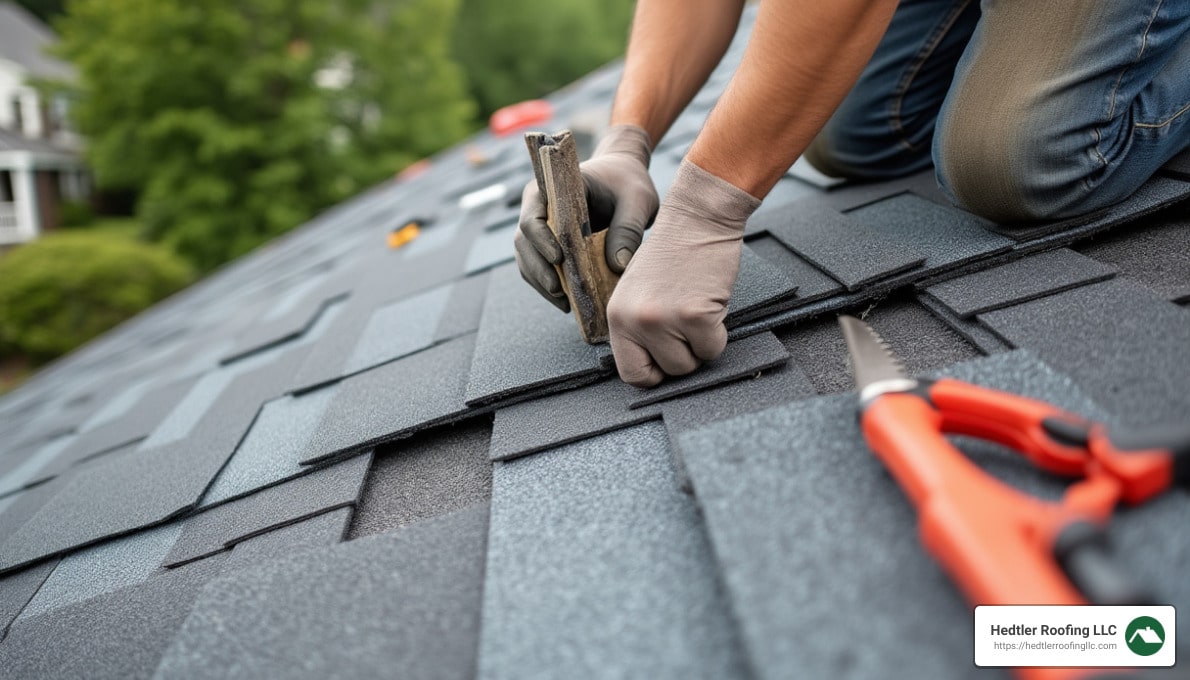Felt Roof Replacement Cost: Top 3 Best Savings 2024
When considering felt roof replacement cost, it’s key to understand that various factors can impact the overall expense. From the type of felt you choose to the specific requirements of your Massachusetts home, costs can vary significantly. Generally, homeowners in Massachusetts might expect a straightforward felt roof replacement to range from $2,000 to $9,000, depending on size and complexity.
Key Cost Factors:
– Type of Felt: Options include torch-on felt, self-adhesive felt, and others.
– Roof Size: Larger or more complex roofs cost more.
– Installation: Labor costs fluctuate based on the contractor’s expertise and material.
For homeowners in Franklin or Bellingham, MA, understanding these factors helps ensure you get the most value from your investment while maintaining your home’s durability and aesthetic appeal.
My name is Jason Hedtler, owner of Roof Experts, a reputable roofing firm serving Massachusetts homeowners. With experience in assessing felt roof replacement cost, my team and I are committed to guiding you through the process, ensuring that your roof not only protects but also improves your home.

Felt roof replacement cost terms to know:
– average cost to replace roof shingles
– average cost to tear off and replace roof
– partial roof replacement
Understanding Felt Roof Replacement Cost
When it comes to felt roof replacement cost, understanding the types of felt roofing and their specific costs is crucial for Massachusetts homeowners. Let’s break down the types of felt and what you can expect in terms of pricing.
Types of Felt Roofing
- Torch-On Felt:
- Durability: Known for its strength and long life expectancy, torch-on felt is a popular choice for many.
- Installation: This type requires professional installation due to the use of a blowtorch to apply it. This can increase labor costs but ensures a strong bond and weather resistance.
- Self-Adhesive Felt:
- Ease of Use: As the name suggests, this felt has an adhesive backing, making it easier to install. It’s a great option for DIY enthusiasts.
- Cost and Lifespan: Generally cheaper to install but may not last as long as torch-on felt, especially in harsh weather conditions.
- Shed Roof Felt:
- Affordability: Ideal for smaller projects like garden sheds, this felt is the most budget-friendly.
- Application: Typically installed using nails or adhesive, making it simple and quick for small areas.
Cost Breakdown
Understanding the costs involved in felt roof replacement helps homeowners make informed decisions.
- Material Costs:
- Torch-On Felt: Higher material cost due to its durability.
- Self-Adhesive Felt: Mid-range cost, balancing ease of installation with moderate durability.
- Shed Roof Felt: Lowest cost, suitable for non-critical structures.
- Labor Costs:
- Torch-On Felt: Higher due to the need for skilled labor and safety precautions during installation.
- Self-Adhesive Felt: Lower as it requires less specialized equipment.
- Shed Roof Felt: Minimal, often a quick job for professionals or DIY.
- Total Cost Range:
- Homeowners can expect total costs to range from $2,000 to $9,000. This range depends on the type of felt, roof size, and complexity.
For those in Massachusetts, these insights into felt roof replacement cost can guide you to choose the right type of felt and understand the associated expenses. Whether you’re opting for a durable torch-on felt for your main house or a simple shed roof felt for your garden, knowing these details helps in planning and budgeting effectively.

Factors Influencing Felt Roof Replacement Costs
When planning a felt roof replacement, understanding the factors that affect costs is key. Let’s explore how roof size, complexity, and material quality can impact the overall expenses for Massachusetts homeowners.
Roof Size and Complexity
Roof Size:
The size of your roof is one of the most significant factors in determining the cost. Larger roofs naturally require more materials and labor, which increases the cost. For example, replacing the felt on a 1,000 square foot roof might cost between $4,452.50 and $6,034.17, while a 2,500 square foot roof could range from $11,131.25 to $15,085.42.
Roof Complexity:
The complexity of your roof’s design also plays a role. A simple, single-story roof is easier and cheaper to replace than a multi-story roof with steep pitches and multiple facets. Complex roofs require more time and specialized labor, which can drive up costs. For instance, working around existing penetrations like skylights or vents can increase labor time and expenses.
Material Quality and Type
Asphalt Felt:
- Cost: Asphalt felt is typically the most affordable option. It’s suitable for mild climates and works well with asphalt shingles.
- Durability: While not fully waterproof, it offers decent water resistance and can last 20 to 30 years with proper maintenance.
Synthetic Felt:
- Cost: This type is more expensive than asphalt but offers superior weather resistance.
- Durability: Synthetic felt is waterproof and resistant to UV rays, high winds, and extreme temperatures. It can last 25 to 30 years, making it a popular choice for those seeking longevity.
Rubberized Felt:
- Cost: The most costly of the three, rubberized felt is often self-adhesive, which can increase installation costs.
- Durability: It provides excellent waterproofing and is ideal for roofs exposed to harsh weather conditions.

Choosing the Right Material:
When selecting felt for your roof, consider the local climate, your budget, and the specific needs of your home. While asphalt felt might be cost-effective, synthetic or rubberized options could offer better protection and longevity, potentially saving money in the long run.
By understanding these factors, Massachusetts homeowners can make informed decisions about their felt roof replacement, ensuring they choose the right materials and understand the associated costs. Next, we’ll compare felt roof replacement with other roofing options to provide a broader perspective on your choices.
Comparing Felt Roof Replacement with Other Roofing Options
When it comes to roofing, Massachusetts homeowners have several options. Let’s explore how felt roof replacement stacks up against other roofing types, focusing on flat roofs vs. pitched roofs and the costs and benefits of different materials like metal, tile, and shingle roofing.
Flat Roofs vs. Pitched Roofs
Flat Roofs:
Flat roofs are often chosen for their modern look and ease of maintenance. They’re generally less expensive to install than pitched roofs because they cover less surface area, reducing material and labor costs. However, flat roofs can be more prone to water pooling, which may lead to leaks if not properly maintained.
Pitched Roofs:
Pitched roofs are the traditional choice and are known for their excellent drainage capabilities. This design minimizes water accumulation, which can lead to fewer issues over time. However, pitched roofs typically come with higher installation costs due to their complexity and the increased amount of materials required.
Cost Comparison:
- Installation Costs: Flat roof installations can be more cost-effective initially, but maintenance costs might add up over time. Pitched roofs, while more expensive to install, may offer better long-term durability.
- Energy Efficiency: Pitched roofs often provide better insulation, which can lead to energy savings. Flat roofs can be optimized with reflective materials to improve their energy efficiency.
Other Roofing Materials
Metal Roofing:
Metal roofs are known for their durability and longevity, often lasting 50 years or more. They are energy-efficient, reflecting solar heat, which can lower cooling costs. However, the initial material costs are higher compared to felt or shingle roofs.
Tile Roofing:
Tile roofs, whether clay or concrete, offer a classic look and are highly durable. They provide excellent insulation and are resistant to harsh weather. The downside is their weight and cost, which are both significantly higher than felt roofing.
Shingle Roofing:
Shingle roofs are a popular choice due to their affordability and ease of installation. They offer a variety of styles and colors, making them versatile for different home designs. While they are less durable than metal or tile, they are easier and cheaper to repair.
Choosing the Right Roofing Material:
When selecting a roofing material, consider the climate, budget, and aesthetic preferences. Each material has its pros and cons, and the best choice depends on your specific needs and circumstances. For example, while felt roofing might be cost-effective, investing in metal or tile could provide better long-term value.
By comparing these options, Massachusetts homeowners can make informed decisions about their roofing needs, balancing initial costs with long-term benefits. Next, we’ll address some frequently asked questions about felt roof replacement to help guide your choices further.
Frequently Asked Questions about Felt Roof Replacement
How often should a felt roof be replaced?
Felt roofing typically lasts between 15 to 30 years, depending on the material quality and the local climate. Regular maintenance can extend this lifespan. For example, checking for tears or blisters and ensuring proper drainage can prevent small issues from becoming costly repairs.
Maintenance Tips:
- Inspect regularly: Look for signs of wear, especially after severe weather.
- Clear debris: Keep the roof free of leaves and branches to prevent water buildup.
- Repair promptly: Fix minor damages quickly to avoid bigger problems.
Should old felt be removed before replacement?
Overlaying a new felt roof over the old one is possible, but it’s not always recommended. If the existing roof is in good condition, adding a new layer can save on removal costs and provide extra insulation. However, if there are signs of damage like leaks or rot, it’s best to remove the old felt to ensure a solid foundation for the new roof.
Overlay Options:
- Insulation benefits: An additional layer can improve thermal performance.
- Cost savings: Avoiding removal can reduce labor and disposal expenses.
Is felt roofing waterproof?
Felt roofing is water-resistant, which means it can effectively shed water and protect your home from the elements. However, it’s not entirely waterproof. Over time, exposure to harsh weather can compromise its water resistance, so proper installation and regular maintenance are crucial for ensuring durability.
Material Durability:
- Asphalt felt: Offers good water resistance but may require more maintenance.
- Synthetic felt: Generally more durable and resistant to UV rays and tearing.
- Rubberized felt: Provides excellent waterproofing and flexibility.
By understanding these aspects of felt roofing, Massachusetts homeowners can better plan for maintenance and replacement, ensuring their roofs remain protective and cost-effective over time.
Conclusion
At Roof Experts, we understand that your roof is a vital part of your home. For Massachusetts homeowners, choosing the right roofing solution is crucial for both protection and value. Our team, with over 20 years of experience, is here to help you steer the complexities of felt roof replacement costs and ensure you make informed decisions.
Expert Advice You Can Trust
Choosing us means you get access to expert advice custom to the unique climate challenges of Massachusetts. Our commitment to quality workmanship and customer service means your roof will withstand the harsh winters and humid summers typical of this region.
Here’s why Massachusetts homeowners choose Roof Experts:
- Local Expertise: We’re familiar with local building codes and weather conditions, ensuring your project meets all standards.
- Quality Materials: We use only the best materials to ensure durability and longevity.
- Comprehensive Services: From detailed inspections to complete replacements, we handle it all with precision and care.
Your Next Steps
Whether you’re considering a new felt roof or need help with maintenance, we’re ready to assist. Our free inspections and detailed estimates offer transparency and peace of mind. Let us help protect your home with a roof that stands the test of time.
For more information or to schedule a consultation, visit our Roof Replacements page. We’re here to provide the protection your home deserves.


